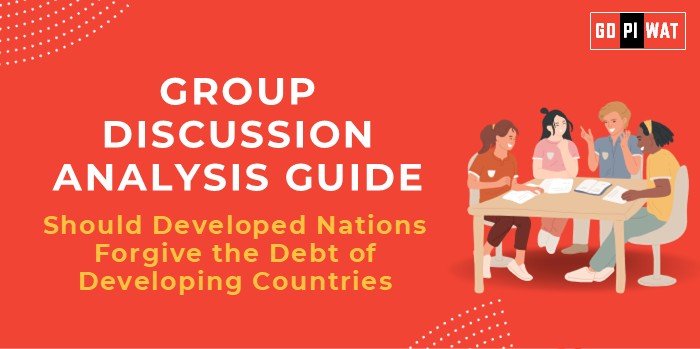📋 Group Discussion Analysis Guide
💬 Should Developed Nations Forgive the Debt of Developing Countries?
💡 Introduction to the Topic
🌱 Opening Context: The debate on whether developed nations should forgive the debt of developing countries touches on global financial stability, economic justice, and international relations. It has gained prominence in light of the economic fallout from the COVID-19 pandemic and climate change-related disasters.
📜 Topic Background: Historically, debt forgiveness has been a tool to aid development, notably through initiatives like the Highly Indebted Poor Countries (HIPC) program. Renewed calls for action have emerged due to rising debt distress among developing nations, exacerbated by inflation and the global slowdown.
📊 Quick Facts and Key Statistics
- 💵 Global Debt of Developing Nations: $9 trillion in 2024 (IMF Report).
- 📉 Debt-to-GDP Ratio in Low-Income Countries: Averaging 60% (World Bank, 2023).
- ✔️ Debt Relief Efforts: HIPC reduced $100 billion in debt for 36 countries (World Bank).
- 📉 Economic Impact: Each 1% increase in debt servicing reduces education and healthcare spending by 3% (UNDP Study, 2023).
🌍 Stakeholders and Their Roles
- 🏛️ Developing Nations: Struggle with poverty alleviation and infrastructure development under heavy debt servicing.
- 🌐 Developed Nations: Lenders controlling significant voting power in international financial institutions.
- 💼 Multilateral Institutions: IMF and World Bank mediate and implement debt relief initiatives.
- 🤝 NGOs and Advocacy Groups: Drive awareness and pressure for fair debt practices.
- 👥 Global Citizens: Bear long-term economic consequences of poorly managed global debt crises.
🏆 Achievements and Challenges
🌟 Achievements:
- ✔️ Successful Debt Relief Programs: HIPC cut debt significantly, boosting GDP growth by 2% in participating nations.
- ⚕️ Social Gains: Debt forgiveness led to a 15% increase in healthcare spending in recipient countries.
- 📚 Regional Examples: Rwanda used savings from debt relief to achieve 90% primary education enrollment.
⚠️ Challenges:
- 🔄 Recurring Debt Cycles: Many countries return to debt distress within a decade.
- ⚖️ Sovereignty vs. Conditionality: Debt relief often ties to strict economic reforms, limiting autonomy.
- 🌍 Unequal Burden: Creditor nations fear moral hazard and feel overburdened.
🌍 Global Comparisons:
- ✅ Success: Norway’s debt forgiveness for 7 countries led to sustainable development gains.
- ❌ Failures: Argentina’s partial debt restructuring triggered years of stagnation.
📜 Case Study:
- 🌟 Zambia: Benefited from HIPC but relapsed into distress due to declining copper prices and excessive borrowing.
✨ Structured Arguments for Discussion
- 💬 Supporting Stance: “Debt forgiveness fosters equitable development and strengthens global stability.”
- ⚖️ Opposing Stance: “Debt relief discourages financial discipline and creates dependency.”
- 🔄 Balanced Perspective: “Debt relief, if tied to governance reforms, can balance equity and responsibility.”
🎯 Effective Discussion Approaches
📖 Opening Approaches:
- 📜 Historical Perspective: “Debt relief has historically transformed economies, as seen with HIPC.”
- 🌍 Moral-Economic Argument: “Economic justice necessitates debt relief for equitable global progress.”
- 📊 Data-Driven Insight: “With $9 trillion in debt, developing nations cannot sustain essential services.”
🔄 Counter-Argument Handling:
- ✔️ “While dependency risks exist, conditional debt forgiveness addresses structural issues.”
- ✔️ “Forgiving debt selectively based on governance ensures responsible use of relief.”
📈 Strategic Analysis of Strengths and Weaknesses
- 💪 Strengths: Proven economic and social benefits; strengthens global economic interdependence.
- ⚠️ Weaknesses: Risk of recurring debt; potential misuse without stringent conditions.
- 💡 Opportunities: Build sustainable global partnerships; promote SDGs by reallocating funds to development.
- 🚨 Threats: Political backlash in creditor nations; loss of confidence in international lending.
📚 Connecting with B-School Applications
- 🌟 Real-World Applications: Analyze financial models of debt sustainability in macroeconomics courses; examine governance impact in policy studies.
- 💬 Sample Questions:
- “What are the implications of debt forgiveness on global trade?”
- “Should debt relief be tied to climate action? Why?”
- 📖 Insights for Students:
- Understanding the interplay of ethics and economics.
- Exploring innovative funding mechanisms for sustainable development.


